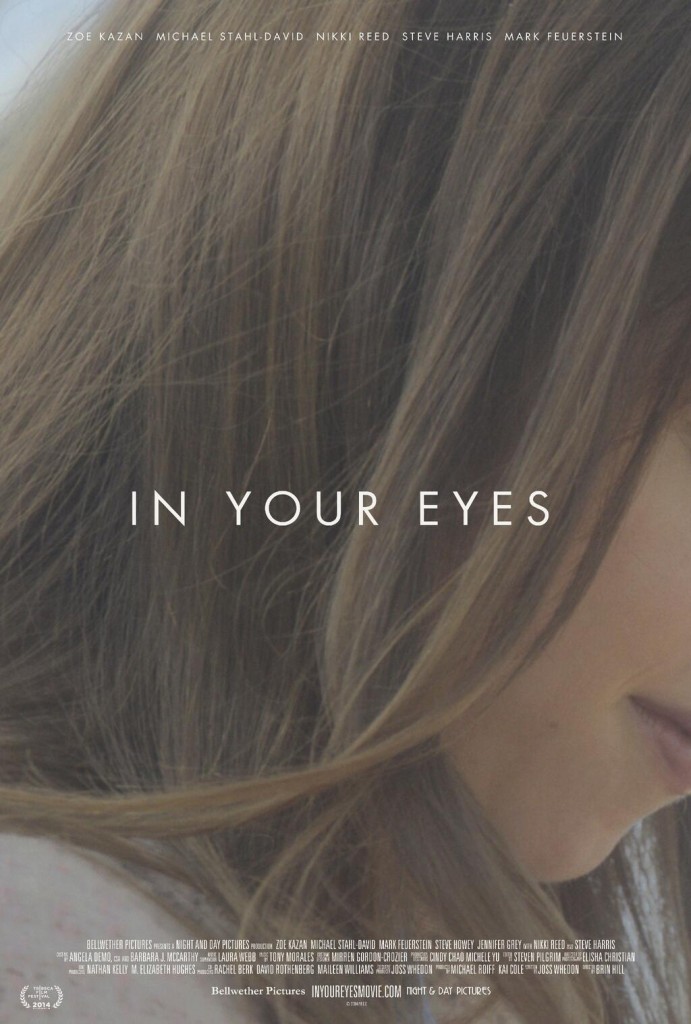Myth & Movie: Masculine and Feminine: A Dysfunctional Love Story

Joss Whedon wrote a film that kind of blew my mind with how well it played out the archetypal dynamic between the Masculine and Feminine.
The film is called “In Your Eyes,” and there are going to be a lot of spoilers for it here, so if that’s not your thing . . . well, stop reading or don’t watch the movie.
But you should watch the movie. It’s on Netflix.
I’ll wait.
. . .
Watched it?
Good.
First, let’s have a quick reminder about what the Masculine and Feminine are.
I’m talking in Jungian archetypal terms here.
Every woman has a masculine side. That’s her animus.
And every man has a feminine side. That’s his anima.
The Masculine and Feminine have different qualities. Not better or worse—but strongly opposite to one another.
The Masculine has force and agency on his side. This means he can get things done. He knows how to build things and buck the system and go against authority. He’s a badass. But that’s only when he’s healthy. If he’s dysfunctional, he’s a violent criminal who can’t create anything of value.
The Feminine has love and beauty on her side. She’s kind, loyal, and imaginative. She brings meaning to life. She’s a sweetheart. But that’s only when she’s healthy. If she’s dysfunctional, she’s a weak-willed ninny who can’t speak her mind and obeys authority compulsively.
They are polar opposites, Yin and Yang, and they are in love with each other. They’re not in love just because of that “Opposites Attract” song (even though that music video was awesome). They’re in love because, in order to be a fully realized human being, everyone has to have both Masculine and Feminine in good amounts. They’re in love because they are SUPPOSED to be one being. They are literally soul mates.
Want a demonstration of what this looks like? Of how the Masculine and Feminine partner and support one another? Watch “In Your Eyes,” or read on.
At first I was skeptical about this movie…
…because the premise sounded kind of cheesy. It’s about a man and a woman who share this telepathic bond and can experience life through one another’s eyes. But it also sounded really archetypal, so I watched it, and within the first 20 minutes it became one of my favorite mythic movies ever.
Joss Whedon wrote it. (If nothing else sells you, those four words should.)
The main characters are Becky (the Feminine) and Dylan (the Masculine).
They’re on opposite sides of the country—he’s in New Mexico, and she’s in New Hampshire—and they don’t know one another.
They are both dysfunctional like a riot.
Dylan’s been in prison. He works at a car wash and lives in a trailer out in the desert, in a wasteland full of old junk and car parts. He has never had a girlfriend (because the dysfunctional Masculine has no skill with emotions). He’s trying really hard to be anything other than what he is, but he just can’t seem to grow. His parole officer’s all like, “Stop being a f—-up.” And Dylan’s like, “I can’t stop being a f—-up!”
Becky’s been in a mental institution. She’s married to a doctor who serves as a father figure. He’s not a bad man, but he is over-protective. He controls her and belittles her. (When she wants another glass of wine, he cuts her off. When she starts to say “schizophrenic narco—” he cuts her off and pats her shoulder and says, “Narcopathy. It’s a big word.”)
Dylan makes bad decisions, and Becky can’t make decisions at all.
He has a shit job, and she doesn’t work at all.
And then, by the magic of movie magic, they realize they have a telepathic connection with one another. They can see through one another’s eyes. They can talk to one another, but only if they speak out loud. (They can’t read one another’s thoughts.) So they both walk around talking to themselves (in more ways than one—yeah, she’s talking to herself, but also to her own animus). And they both look crazy.
They ARE crazy. They’re dysfunctional because they’re separated.
After they get over the freakishness of it all, they get to know one another. Dylan gets self-conscious of how messy his trailer is, and immediately begins cleaning it up. He takes the old car parts strewn around his home, and he plants flowers in them. He strings up lights and lays flagstones.
Right away, he begins integrating Becky’s Feminine qualities.
When his old friends, the violent criminals, come calling and try to involve him in a new criminal job, Dylan doesn’t want to do it.
“Come on,” says Violent Criminal Friend. “Who’s gonna know?”
Dylan doesn’t answer, but he knows exactly who will know: Becky.
Suddenly, not being a violent criminal matters more than ever.
Dylan helps Becky out, too.
She gains confidence, and starts to see that her husband might be a little less than supportive of her as a fully-realized independent woman. She gets less tolerant of people belittling her. When she’s at the mechanic because her car is making a funny rattling sound, Dylan hears the guy say it’s going to be a $1200 repair.
“What?” Dylan says, sneering as he’s potting flowers in an old tire. “Turn on the engine.” Becky does. “Okay, now go look under the hood.” So Becky looks under the hood of her car and Dylan directs her to the problem, which she manages to fix right then and there.
That wasn’t a man fixing the problem for her. That was her Masculine side, stepping up and giving her power.
Right away, she begins integrating Dylan’s Masculine qualities.
So things progress, la de da.
Becky helps Dylan get a date, and tells him the right things to say to woo the lady.
They talk about their pasts, and Becky admits that she is afraid of her husband. “All they ever taught me was how to be afraid. And I went out and found the copingest man alive, so he could take care of me.”
That’s the dysfunctional Feminine recognizing her plight right there.
But Becky doesn’t want to be taken care of anymore. She wants to be a grown up woman.
Of course, they are falling in love. This was always a love story. They’re empowering one another, and they’re literally seeing a new world—she looks through his eyes and sees a New Mexico sunset. He looks through hers and sees a snowman she built. They both see beauty, because they’re not only seeing their opposite . . . they’re seeing themselves; a part of themselves they thought wasn’t even there.
The end is so awesome.
Dylan’s Violent Criminal Friends use violence to try to draw Dylan back into being a criminal.
Becky’s over-protective husband re-institutionalizes her. She is now the princess locked in the tower (which is another manifestation of the dysfunctional Feminine).
Dylan realizes he has to come save her. He is now the knight coming to save the princess. He evades not only his old friends, but also the cops who are on his tail. He is finally using his capacity for violence and force in a positive, constructive way. (Go Masculine!) She brought that out of him. She (his anima) essentially said to him, “I see your heart and it is good. I admire the way you’re able to break the rules.” And he lived up to that vision of himself.
However, there is that little matter of Dylan being all the way across the country from Becky.
Fortunately, they’ve got this telepathy thing going on. And he tells her how to pick the lock on her door to escape the institution.
You guys. That is the f—-ing awesome part. The Knight saved the Princess . . . by EMPOWERING HER TO SAVE HERSELF. Because he’s literally in her head. He’s not an external hero. The Knight is a PART of the Princess.
This is how we raise one another up.
This is how we raise OURSELVES up.
His tendency for violence and rule breaking has been a bad thing up to this point. Now, it’s essential. Without it, she’d die.
Her tendency for obeying authority has kept her weak up to this point. But following the authority of her own animus allows her to break the rules.
In the end they manage to connect and hop a train car to Canada. The first time Becky sees Dylan (and vice versa), she’s literally meeting the part of herself that saved her life, that made her whole.
And that’s how Jungian love at first sight works, kids.

Read more about the animus and anima and their timeless love story in your head:
http://www.trans4mind.com/jamesharveystout/anima.htm
***
© Leslie Hedrick 2015. The content of this article, except for quoted or linked source materials, is protected by copyright. Please contact me to request usage.
SUBSCRIBE